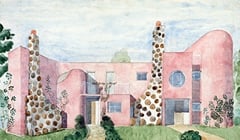When Estrid Ericson founded Svenskt Tenn in 1924, pewter had already established itself as one of the most exciting materials of the age. At the time, only a handful of shops sold pewter goods created by celebrated artists and designers such as Estrid Ericson, Nils Fougstedt, Anna Petrus Lyttkens, Edvin Öhström and Björn Trägårdh.
During the 1920s, modern pewter was in demand and competed with glass and ceramics, rather than with other metals. The material was exciting and in vogue and inspired the art teacher Estrid Ericson with a vision and an idea: She would offer the general public fashionable pewter art at reasonable prices. As artistic collaborator and head designer, she had with her the well-known pewter designer Nils Fougstedt.
During the summer of 1924, they decided to start the “Handicrafts workshop” (Konsthantverkets verkstad) and, together with two employed metalworkers, they began to produce and sell pewter goods on Kungsholmstorg in Stockholm. There was great interest in the goods and, a mere few months later – in October 1924 – Estrid Ericson, on her own, founded Firma Svenskt Tenn, with a store and workshop on Smålandsgatan. Her vision had now taken further shape and she commissioned the functionalist architect Uno Åhrén to fit out the new store premises. The concept won acclaim and was noticed by among others, the newspaper Nya Dagliga Allehanda which, in an article entitled “The artist at the chill mould and at the counter” wrote:
“... She envisions realising quite an original project. In fact, she intends to move her workshop to new premises, which she has leased at Smålandsgatan 40. But here she also intends to fit out a store in which she personally intends to stand behind the counter and serve her customers, when she isn’t spending time on the workshop floor, decorating pewter goods.”
For the opening of the store, Estrid Ericson commissioned Svenskt Tenn’s logo from the leading graphic designer of the day, Akke Kumlien. Bertil Lybeck sketched two angels in the seal, which nowadays has come to be known as the “Angel Mark”. Historically, winged figures were often depicted in hallmarks, thereby guaranteeing the highest quality pewter. Since then, Svenskt Tenn’s own pewter goods have always been stamped with the Angel Mark.
At the 1925 World Exhibition in Paris, Firma Svenskt Tenn was awarded a gold medal for its unique pewter goods – barely a year after the company had been founded. Two years later, the store and the pewter workshop moved to new, larger premises at Strandvägen 5. Once again, Uno Åhrén was commissioned to design the interior, and the local newspapers reported that something similar had seldom been witnessed in Stockholm. Readers were encouraged to visit the store to see “Herr Åhrén’s modern interior”, since such a type of interior was otherwise only seen in major cities such as London or New York.
Svenskt Tenn has now been housed in the premises at Strandvägen 5 for 90 years. The product range still includes several of the pewter goods from the 1920s including Anna Petrus’ Pewter Lion, Nils Fougstedt’s Pipes vase and Estrid Ericson’s classic Schnapp’s Fish (Brännvinsfisken). The range is both historical and contemporary and the store continues to be a constantly evolving scene – entirely in the spirit of its founder and pewter enthusiast, Estrid Ericson.










































































